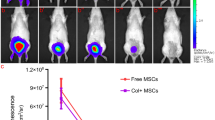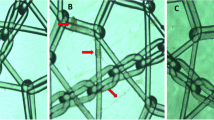Abstract
In order to evaluate the effects of human umbilical cord–derived stem cells (HUMSCs) on the biocompatibility of and tissue response to a polypropylene (PP) mesh (Gynemesh™ PS) implanted in rat vaginas, HUMSCs were isolated and characterized in vitro and then combined with Gynemesh™ PS to create a tissue-engineered mesh. This tissue-engineered mesh and pure PP mesh were implanted in the submucosae of the posterior vaginal walls of rats. Mesh/tissue complexes were harvested at 1, 4 and 12 weeks after implantation. Histological evaluations including an assessment of the inflammatory reaction, neovascularization and fibrosis around the mesh fibers were performed and real-time quantitative polymerase chain reaction (RT-PCR) was used to analyze the mRNA expression of genes involved in wound healing at the tissue-mesh interface. After being seeded onto the PP mesh scaffold, HUMSCs grew and proliferated well in vitro culture. One week after implantation, the HUMSC-seeded mesh elicited a greater inflammatory response than the pure PP mesh (3.33 ± 0.21 vs. 2.63 ± 0.18, p = 0.026), while 4 and 12 weeks after implantation, the inflammatory response in the HUMSC-seeded mesh was lower than that in the unseeded mesh (p < 0.05). At 12 weeks, the HUMSC-seeded mesh induced a lower expression of matrix metalloproteinase (MMP)-1 and a higher expression of anti-inflammatory cytokine interleukin (IL)-4. HUMSCs may decrease the inflammatory response and improve the biocompatibility of a conventional synthetic mesh and may have the potential to reduce postoperative complications such as mesh exposure or erosion.






Similar content being viewed by others
References
Alberti C (2009) Tissue engineering technologies: just a quick note about transplantation of bioengineered donor trachea and augmentation cystoplasty by de novo engineered bladder tissue. Il Giornale di chirurgia 30(11–12):514–519
Anderson JM, Rodriguez A, Chang DT (2008) Foreign body reaction to biomaterials. Semin Immunol 20(2):86–100
Balasubramanian S, Thej C, Venugopal P, Priya N, Zakaria Z, Sundarraj S, Majumdar AS (2013) Higher propensity of Wharton's jelly derived mesenchymal stromal cells towards neuronal lineage in comparison to those derived from adipose and bone marrow. Cell Biol Int 37(5):507–515
Barrientos S, Stojadinovic O, Golinko MS, Brem H, Tomic-Canic M (2008) Growth factors and cytokines in wound healing. Wound Repair Regen 16(5):585–601
Batsali AK, Kastrinaki MC, Papadaki HA, Pontikoglou C (2013) Mesenchymal stem cells derived from Wharton's jelly of the umbilical cord: biological properties and emerging clinical applications. Current stem cell research & therapy 8(2):144–155
Caplan AI, Dennis JE (2006) Mesenchymal stem cells as trophic mediators. J Cell Biochem 98(5):1076–1084
Deprest J, Zheng F, Konstantinovic M, Spelzini F, Claerhout F, Steensma A, Ozog Y, De Ridder D (2006) The biology behind fascial defects and the use of implants in pelvic organ prolapse repair. Int Urogynecol J Pelvic Floor Dysfunct 17(Suppl 1):S16–S25
Dominici M, Le Blanc K, Mueller I, Slaper-Cortenbach I, Marini F, Krause D, Deans R, Keating A, Prockop D, Horwitz E (2006) Minimal criteria for defining multipotent mesenchymal stromal cells. The international society for cellular therapy position statement. Cytotherapy. 8(4):315–317
Funk MJ, Edenfield AL, Pate V, Visco AG, Weidner AC, Wu JM (2013) Trends in use of surgical mesh for pelvic organ prolapse. Am J Obstet Gynecol 208:79.e1-7
Griffin MD, Elliman SJ, Cahill E, English K, Ceredig R, Ritter T (2013) Concise review: adult mesenchymal stromal cell therapy for inflammatory diseases: how well are we joining the dots? Stem Cells 31(10):2033–2041
Ho MH, Heydarkhan S, Vernet D, Kovanecz I, Ferrini MG, Bhatia NN, Gonzalez-Cadavid NF (2009) Stimulating vaginal repair in rats through skeletal muscle-derived stem cells seeded on small intestinal submucosal scaffolds. Obstet Gynecol 114(2 Pt 1):300–309
Huffaker RK, Muir TW, Rao A, Baumann SS, Kuehl TJ, Pierce LM (2008) Histologic response of porcine collagen-coated and uncoated polypropylene grafts in a rabbit vagina model. Am J Obstet Gynecol 198(5):582 e581–582 e587
Kropp BP, Cheng EY (2000) Bioengineering organs using small intestinal submucosa scaffolds: in vivo tissue-engineering technology. J Endourol 14(1):59–62
Maher C, Feiner B, Baessler K, Schmid C (2013) Surgical management of pelvic organ prolapse in women. The. Cochrane Database Syst Rev 4:Cd004014
Mason C, Manzotti E (2010) Regenerative medicine cell therapies: numbers of units manufactured and patients treated between 1988 and 2010. Regen Med 5(3):307–313
Mueller SM, Glowacki J (2001) Age-related decline in the osteogenic potential of human bone marrow cells cultured in three-dimensional collagen sponges. J Cell Biochem 82(4):583–590
Nolfi AL, Brown BN, Liang R, Palcsey SL, Bonidie MJ, Abramowitch SD, Moalli PA (2016) Host response to synthetic mesh in women with mesh complications. Am J Obstet Gynecol 215(2):206 e201–206 e208
Pittenger MF, Mackay AM, Beck SC, Jaiswal RK, Douglas R, Mosca JD, Moorman MA, Simonetti DW, Craig S, Marshak DR (1999) Multilineage potential of adult human mesenchymal stem cells. Science (New York, NY) 284(5411):143–147
Rohban R, Pieber TR (2017) Mesenchymal stem and progenitor cells in regeneration: tissue specificity and regenerative potential. Stem Cells Int 2017:5173732
Roman S, Mangera A, Osman NI, Bullock AJ, Chapple CR, MacNeil S (2014) Developing a tissue engineered repair material for treatment of stress urinary incontinence and pelvic organ prolapse-which cell source? Neurourol Urodyn 33(5):531–537
Sabapathy V, Sundaram B, Sreelakshmi VM, Mankuzhy P, Kumar S (2014) Human Wharton's jelly mesenchymal stem cells plasticity augments scar-free skin wound healing with hair growth. PLoS One 9(4):e93726
Shin M, Abukawa H, Troulis MJ, Vacanti JP (2008) Development of a biodegradable scaffold with interconnected pores by heat fusion and its application to bone tissue engineering. J Biomed Mater Res A 84(3):702–709
Ulrich D, Edwards SL, Su K, Tan KS, White JF, Ramshaw JA, Lo C, Rosamilia A, Werkmeister JA, Gargett CE (2014) Human endometrial mesenchymal stem cells modulate the tissue response and mechanical behavior of polyamide mesh implants for pelvic organ prolapse repair. Tissue Eng Part A 20(3–4):785–798
von Bahr L, Batsis I, Moll G, Hagg M, Szakos A, Sundberg B, Uzunel M, Ringden O, Le Blanc K (2012) Analysis of tissues following mesenchymal stromal cell therapy in humans indicates limited long-term engraftment and no ectopic tissue formation. Stem Cells 30(7):1575–1578
Wang HS, Hung SC, Peng ST, Huang CC, Wei HM, Guo YJ, Fu YS, Lai MC, Chen CC (2004) Mesenchymal stem cells in the Wharton's jelly of the human umbilical cord. Stem Cells 22(7):1330–1337
Weiss ML, Anderson C, Medicetty S, Seshareddy KB, Weiss RJ, VanderWerff I, Troyer D, McIntosh KR (2008) Immune properties of human umbilical cord Wharton's jelly-derived cells. Stem Cells 26(11):2865–2874
Wu KH, Chan CK, Tsai C, Chang YH, Sieber M, Chiu TH, Ho M, Peng CT, Wu HP, Huang JL (2011) Effective treatment of severe steroid-resistant acute graft-versus-host disease with umbilical cord-derived mesenchymal stem cells. Transplantation. 91(12):1412–1416
Yoon E, Dhar S, Chun DE, Gharibjanian NA, Evans GR (2007) In vivo osteogenic potential of human adipose-derived stem cells/poly lactide-co-glycolic acid constructs for bone regeneration in a rat critical-sized calvarial defect model. Tissue Eng 13(3):619–627
Zimmermann CE (2011) Survival of transplanted rat bone marrow-derived osteogenic stem cells in vivo. Tissue Eng Part A 17(7–8):1147–1156
Funding
This study received financial support from the National Natural Science Foundation of China (No. 81571421).
Author information
Authors and Affiliations
Corresponding author
Ethics declarations
Conflict of interest
The authors declare that they have no conflicts of interest.
Additional information
Publisher’s note
Springer Nature remains neutral with regard to jurisdictional claims in published maps and institutional affiliations.
Electronic supplementary material
ESM 1
(DOCX 16.2 kb)
Rights and permissions
About this article
Cite this article
Deng, M., Ding, J., Ai, F. et al. Impact of human umbilical cord–derived stem cells (HUMSCs) on host responses to a synthetic polypropylene mesh for pelvic floor reconstruction in a rat model. Cell Tissue Res 382, 519–527 (2020). https://doi.org/10.1007/s00441-020-03234-5
Received:
Accepted:
Published:
Issue Date:
DOI: https://doi.org/10.1007/s00441-020-03234-5




